

A certain George Rixon has published a post on UFODigest (“Ufo and Paranormal News from around the World”) on the subject of Extraterrestrials and the Great Pyramid, apparently based on “the knowledge Aramac (an extraterrestrial) has passed on to [him]”. This ought to grab our attention: after all, as an extraterrestrial, Aramac obviously knows more about Old Kingdom Egypt than any mere Egyptologist, although I can’t help but think that a particularly revolting sweet lurks behind his name…
Unfortunately, it’s not at all clear from Mr Rixon’s text which elements are his own and which derive from his extraterrestrial friend. This is a pity, as I’m sure it would help if we could separate the earthly dross from the heavenly wisdom, but until the poster achieves his true desire (“LOOKING FOR FULL PUBLICATION.OF MANUSCRIPT” (sic)), we’ll just have to go with what’s presented on UFODigest.
We start with accusations against the hieroglyphs containing Ḫwfw’s name:
To begin with it has been thought and taken for fact that the Great Pyramid was built for King Khufu as a burial tomb. This is because his name was written in hieroglyphic markings inside the construction. But, there is great doubt to its authenticity. Some were wrongly spelt, and some with bad grammar, making them appear to be fakes.

Well, this can’t be from CAramac, as it’s just dead wrong: there is no doubt whatsoever about the authenticity of the painted marks, some of which are in gaps between blocks inaccessible to a modern forger, none is wrongly spelled or has poor grammar and the accusation that they were forged by their discoverer, Howard Vyse (1784-1853), made unjustly by Zecharaia Sitchin in his Stairway to Heaven, published in 1983, has been comprehensively debunked.
Next, we move on to the idea that the Great Pyramid was not a tomb:
The theory of a Royal tomb, historians have taken and speak about it as fact even though there is no firm evidence that this was so. The Egyptologist’s say the reason no body has been discovered in the Great Pyramid, was because before it was completed the treasures that were supposed to have been placed there, were stolen. The Pharaoh then abandoned the idea of using the pyramid as a tomb, and used a burial site underground instead.

That’s a slightly new idea: Ḫwfw’s treasure was stolen before construction work on the pyramid was over, so he decided to have an underground tomb instead. Those dastardly palace burglars! Always making off with Pharaoh’s goodies. It’s a pity that Mr Rixon (for I’m sure that Caramac wouldn’t have made this mistake) doesn’t tell us which “Egyptologist’s” (sic) have come up with this ingenious explanation for the lack of Ḫwfw’s mummy inside the pyramid. Going against family tradition, the bereft king decided not to follow in his ancestors’ footsteps by building a pyramid: perhaps he was put off by his father Śnfrw’s greed in having three of them. As George Rixon says, “One would have thought that the treasures would not have been placed in the pyramid until the Pharaoh had actually died”. Quite. Perhaps it was Aramac, after all, who fed him this implausible detail.
We are then vouchsafed the information that the Egyptians weren’t the only ancient people to build pyramids (“many believe it was a phenomenon which only belonged to the Pharaohs but that was not so”). Well, who’d have thought it? Anyone with a knowledge of world history, really. Apparently, “[t]here are the stepped pyramids in Central America, claimed to have been built by the Maya civilisation around 2,500 years ago? Also there are pyramids in Tiahuanaco Bolivia” (sic: punctuation in original). More astoundingly still:
In 1994, Hartwig Hausdorf a German explorer gained permission from the Chinese government, to explore a once forbidden area to outsiders. In doing so, he discovered 100 large pyramids, which had never been seen by anyone in the west before. He claims that some of the pyramids in Shensi Province in Central China are even larger than Egypt’s Great Pyramid, dating back some 5,000 years. Excavations in that area will not begin until sometime in this century.

Herr Hausdorf (born 1955) is not so much of an explorer as a former travel agent who has turned his talents to writing on pseudoscientific topics, with a particular focus on what is unnecessarily kindly termed PalaeoSETI. It is more often known as the Ancient Astronauts hypothesis, particularly associated with Erich von Däniken. Again, our information is presumably not from Mr Rixon’s alien chum, as it’s wrong: the mound tombs of Shaanxi province were known in the west long before 1994 (unless Aramac had not yet observed Earth when Emperor Qin’s terracotta army was discovered in 1974 close to his tomb mound). And this despite those secretive Chinese authorities informing “a New Zealand airline pilot named Bruce Cathic” in 1962 that there are no pyramids in their country. The cheek of it! Not deterred by this brush-off, good old Bruce “was nevertheless able to confirm the existence of several of them and in a book called the ‘Ridge of Infinity’ he suggested there is a network of pyramids over the surface of the earth, whose purpose is connected with leys lines and earth energies?” (sic: punctuation in original). Ah yes, “ley lines and earth energies”. We’re still not in the realms of Aramac: what ET would be so foolish as to believe in non-existent ley lines and earth energies?

The list goes on (and on…). There are pyramids “near the town of Guimar on Tenerife… [i]n Trujillo Peru… in Caral Peru… [i]n the valley of Mexico in ancient Teotihuacán… There are many small pyramids that can be seen across Europe from France to Greece. In 2003 in Italy a pyramid was found and in 2005 another was unearthed in Bosnia. Pyramids are still being discovered in some parts of the world where in the past they have been hidden underground such as Bosnia.” Aramac can’t have been misled by the ridiculous claims of Semir (Sam) Osmanagic about Bosnian pyramids, so we must still be reading George Rixon’s contribution.
Oh well, at least there are some pyramids elsewhere in the world. We can accept that much. Time to move on, this time to a discussion of construction techniques. Like typical Bad Archaeologist, Mr Rixon (for it is surely he, not Aramac, who is misrepresenting Egyptologists) frets that “[a] number of documentaries over the years shown on TV have seriously undermined the precision required to complete the Great Pyramid in its construction”. I think he means “underestimated” rather than “undermined”. An alien would be more careful with his English, I’m sure. Mr Rixon doesn’t like the idea that the pyramid builders might have used a plumb-bob, as it’s not sophisticated enough to “achieve the very precise measurements in that manner. And yet no one challenges the documentary makers” apart from the brave souls like George Rixon who know that you need complicated equipment to construct a heap of stones.
There then follows a section on averages. At least, I think that’s what being discussed, but it gets derailed by a discussion of the “national average wage… for the workers of this country” (I assume the country to be the UK as pounds are mentioned, unless Aramac’s home also pays its workers in sterling). We’ll avoid this section, not because it’s incoherent (which it is) but because there must be better stuff to come.

We move into a discussion about how the limestone blocks were quarried. Once again, Mr Rixon has been watching his television carefully. Not carefully enough, though, as he has completely misunderstood the use of heat as a means of fracturing the blocks. Fire was used to weaken the stone before using wooden wedges driven into the rock in lines, which would then be soaked in water to make them expand, pushing stone away from the quarry face. There are still quarries in Egypt where the rock has been prepared to take the wedges but abandoned before being used. He seems to think that the use of water-soaked wedges was a separate technique. Perhaps Mr Rixon was distracted by a telephone call from Aramac and missed that bit. He then brings some of his personal expertise to bear on the question of dressing the stone blocks:
With having a great deal of experience in the building trade I can tell you using stones as tools would have been impossible. You would not be able to get the very precise measurements required in the stone dressing process. Also the workers would have had to wear modern day gloves, especially made for that kind of hard work. To hold one stone as a form of chisel and the other as a pounder would mean after an hour or two both hands would ache so much where the workers would not be able to hold those stone implements. Their hands would soon become sore creating blisters and even if they had used gloves the same problem would arise. The heat of the sun through the gloves would make the hands extremely hot where irritation between the glove and the hand would become so severe again the hands would become sore creating blisters.

Well, I’m not going to try to gainsay that. I’ve never worked as a quarryman, but just from trowelling on an archaeological site, I’m aware of just how painful blistered hands can be and how hot hands can get when wearing gloves. My heart goes out to Pharaoh’s workers. But wait! The workers on the Giza Plateau had access to copper chisels. That would have helped them a lot, although Mr Rixon dismisses the copper chisels as they “would have to be made in their hundreds of thousands if not more, and worn out ones would have to be sharpened every one or two hours as the soft metal would soon be blunt and of no use” and apparently no furnaces for making them have been found “even if they have in time been covered by sand”. Oops! It seems that Mr Rixon hasn’t done his research properly. Here are some Egyptian drawings illustrating the metalworking process from the tomb of Rḫmir‘ (Rekhmirē‘), while here are some photos of the copper working site at TImna, where Egyptians began mining copper long before the Great Pyramid was built.
After a lengthy and unconvincing argument from incredulity about the dressing of the stone, Mr Rixon considers how the finished blocks were moved from the quarry to the pyramid. He seems very taken with the idea of sledges but worries that “copper chisels could not possibly have cut the secure joints needed in the wood in order to hold the sledges together; they would simply have slid on the wood. That could only be achieved with metal chisels similar to those we have today”. According to this logic, nobody could ever have made a sledge (or any other wooden construction needing “secure joints”) before the advent of modern steel tools. It’s a shame, then, that we know that sleds were indeed used and there is a surviving example (complete with its “secure joints”) from the pyramid of Śnwsrt (Senusret or Sesostris) III at Dashur.

We then have another argument from incredulity about the number of pyramids (Mr Rixon counts 94) and the impossibility of building them with the tools available to the Egyptians. Finally, we have the promise that:
The rest of the chapter continues to look at every theory put forward about the Great Pyramid. Such as the impossibilities of it being erected by simple workers. Aramac then gives his explanations of how and why all the pyramids were built that are scattered around the earth, along with those on other planets.
Those poor, simple Egyptians. They can’t possibly have had the mental capacity to build something as complex as a pyramid. But until some enlightened publisher has taken Mr Rixon’s manuscript and given it the “FULL PUBLICATION” it so evidently deserves, we aren’t going to learn anything from Caramac Aramac, not even about those fascinating pyramids on other planets! How disappointing…


What really pisses me off about the “ancient astronauts” idiots is how little faith they have in humanity. At it’s core it’s an ideology which says we can’t build a pyramid, a circle of stones or probably tie our bloody shoelaces without some little gray guy showing us how it’s done!
LikeLike
I like the idea that shoelaces were introduced by ancient aliens.
LikeLike
I find the notion of ancient astronauts no more improbable than the claim that ancient cultures too technologically backwards to have figured out the wheel could nevertheless have accomplished feats that leave modern engineers puzzled. Having faith in humanity doesn’t give us the ability to do things beyond the existing technology, yet the argument seems to be “as impossible as it seems, they must have done it somehow because there it is”. This leaves me to assume that if an archaeologist found an old wooden plank in a tree full of monkeys he would be simply express faith in the incredible abilities, now lost, of monkeydom.
LikeLike
By the way, what about the lack of faith in humanity demonstrated by dismissing ancient scholars as fools, charlatans, liars, or budding science fiction writers when they took the time and trouble to write that they saw gods come down from the sky? No problem in believing they could somehow MacGyver 20 ton granite blocks all over the countryside but can’t believe a word they say. It’s easy to laugh at the fringe ancient astronaut silliness with their hollow moons and faces on Mars, but I prefer to stay open-minded and agnostic when it comes to their core theory. In short, I’ll believe in ancient aliens when they open an ancient tomb and find a ray gun and I’ll believe we did it alone when a classical archaeologist duplicates a Pumapunku granite block using primitive tools and bare hands or, since it’s so simple and easy, builds another Great Pyramid.
LikeLike
Who’s dismissing “ancient scholars”? When you hear the people of programmes like Ancient Aliens quoting ancient writers, they rarely give you the context of the bits they quote. You always have to read any scholar, of any era, in the context of their society, its beliefs and its ways of expressing things.
The von Dänikens of this world think that ancient writers were simpletons, who were unable to understand the technology of their alien visitors and who therefore turned their accounts into tales of gods from the skies. Yet we know that these ancient societies really did believe in gods who lived in the skies, on the tops of mountains, in deep caverns below the earth and so on. They had spiritual experiences of these gods. They devoted time and wealth to them. But you want us to believe that this was nothing more than ancient peoples’ misunderstanding of superior technology? You’re denying these people their religious beliefs.
LikeLike
A lot of people believe in God now, who is little more than a sky god, and yet have no problems also being scientists. Believe it or not, ability in science and belief in religion are not mutually exclusive.
LikeLike
Consider the Jon Frum cargo cult religion on Tanna, Vanuatu. The Jon Frum Church there houses the movement’s most sacred red cross. Every year on the 15th of February, Jon Frum day is celebrated. This is the day when the people believe that Jon Frum will return, bringing with him all the cargo he has promised. Prayers and flowers are offered at the red cross in the village church. This is followed by a flag-raising ceremony and a military parade. Islanders carry rifles made of bamboo, painted to appear as if they have red bayonets. About 100 men march under the command of two village elders dressed as US Army sergeants. The soldiers have the letters “USA” painted in red on their bodies. It’s pretty obvious that Jon Frum was an American Red Cross worker attached to a military unit during WWII who gave the natives supplies during the war and then, mysteriously (to natives with no perspective beyond their own island), left to the Great Beyond.
I certainly do believe that this is nothing more than misunderstanding superior technology, have no problem laughing at their religious beliefs, and am open to the possibility that this isn’t the first time it’s happened. Fast forward 1000 years from now and, to paraphrase Bertrand Russell, if the existence of Jon Frum were affirmed in ancient books, taught as the sacred truth every Sunday, and instilled into the minds of children at school, hesitation to worship him would become a mark of eccentricity and entitle the doubter to the attentions of the psychiatrist in an enlightened age or of the Inquisitor in an earlier time. There will probably also be a web page where debunking the “he was simply an ancient aviator” lie.
LikeLike
After reading this, and the post debunking ancient aliens I wonder if someone could help me make a few more arguments against the suggestion that the Egyptians used advanced technology to build the pyramids? My roommate always seems to bring up the same two points (straight out of the ancient aliens show too by the way) which he believes prove the Egyptians must have had help to build the pyramid at Giza.
His first is that some of the megalithic stones used in ancient Egypt are too large for even modern technology to move, therefore technology more advanced than ours must have bee used to move the stones. I have tried to explaintryst they were quarried out with harder stones and dragged on earthen ramps with ropes and sleds but he still insists they are too big to move this way. I also usually point out that if modern equipment can’t move the stones it’s because there is need to do so, and that if cranes large enough to do so were needed some company would just build one. So my question is: are there actually any megalithic structures in the world with stones that are too large for modern equipment to move?
The other point that he usually argues is that there are all kinds of places where the stones appear to have been cut by a rotating saw blade. I’ve seen the screenshots and honestly the cut marks they show don’t look like the smooth parallel marks I’d expect from a circular saw. But he’s a carpenter (giving him expertise in saws, I guess?) and im a biologist so he rejects my assessment out of hand. So are there any other ways to show that these marks they talk about on the ancient aliens program are not from a modern day saw?
LikeLike
HI, Rob G. I’m already posting my second comment at Bad Archaeology. I’m something of a windbag so I promise, I’ll try to keep it brief.
In short, as to the arguments you’ve had with your roommate, you are of course correct. It might help for him to name a specific example of stone masonry from a particular pharaonic monument, but the Great Pyramid is always a good example. This very argument is often applied to the Great Pyramid. The largest blocks of stone in that pyramid weigh upwards of 50 tons. Yes, that’s extremely heavy, but too heavy for workmen of the Bronze Age to move? Of course not. And I always chuckle when people say MODERN equipment could not move such stones. I think it’s obvious our largest construction cranes can lift a hell of a lot more than that.
As to your second point, that’s also a common argument presented by fans of the fringe. It rings of Chris Dunn in particular. People like Dunn have specialist training in modern technologies but don’t seem too adept at understanding the technologies and capabilities of Bronze Age engineers. The principal building material till the New Kingdom was limestone, and from the New Kingdom on, sandstone. Neither is too difficult for copper or bronze tools to work. Archaeologists like Mark Lehner have spent considerable time in experiential pursuits and have demonstrated that the tools of the Bronze Age were more than up to the task of cutting and shaping these stones. I once watched a video of two modern Egyptians set to sawing through a granite beam with the type of saw we know was used in the Bronze Age, and though it was certainly hard work, they did quite well.
All right, so I didn’t keep it too short. But in closing I would recommend to your roommate that he look into books written by the likes of Craig Smith and Dieter Arnold, who are experts on ancient technology. The answers are out there, the professional literature is abundant, but of one thing I am absolutely certain: real-world answers will NOT be found on that ridiculous television show Ancient Aliens. I sense your roommate might be a fan of that show, although I might be mistaken.
LikeLike
Great article. To further nail this one home, can modern technology move blocks from the great pyramid? YES.
http://www.globalsecurity.org/military/systems/ship/bd.htm
The barge, crane derrick, 115 ton. U.S. military barge, equipped with a crane capable of lifting 115 tons. The largest blocks in the pyramid are 80 tons, and most are smaller. So yes, modern technology can move them.
LikeLike
This is the first time I’ve visited and commented at Bad Archaeology. An acquaintance drew my attention to Bad Archaeology because one of my posts from a forum to which I belong was included in a link near the top of this particular article. It’s the link marked “comprehensively debunked,” in the paragraph next to the image of the cartouche of Khufu. I am not a professional historian but I write quite a lot about civilizations of the ancient Near East (particularly pharaonic Egypt), and more than once I’ve had some of my writing plagiarized. I stress that is NOT the case here because the author of this article provided the link right to my post. If anything, I am flattered. I’ve spent some time perusing the articles of Bad Archaeology and find it to be very interesting and entertaining. It’s also an effective platform to argue against the fringe vapidity that so plagues the internet.
We need more like it. Always. I salute this blog and its usefulness to people of a grounded and logical mind–the kind of people who do not need to turn to aliens or Atlanteans in their quest to learn about ancient civilizations. The fringe does not present reality–it presents a form of sci-fi whimsy that is not to be taken seriously. Ancient history does not require aliens and other flotsam invented by the likes of Erich von Däniken and Zecharia Sitchin. Ancient history, properly studied and understood, is endlessly fascinating all on its own.
Bravo, Bad Archaeology.
LikeLike
The New Zealand pilot is called “Bruce Cathie”
http://en.wikipedia.org/wiki/Bruce_Cathie
LikeLike
A pedant writes…
Snofru built two pyramids, not three. Old Kingdom texts refer to the two pyramids of Snofru (as I recall, the Tomb Biography of Weni mentions the two pyramids of Snofru). The identification of the third as belonging to him is based on Ramesside graffiti inside the Maidum pyramid, which would be better identified as belonging to Huni. The point is, of course, contested, but I think the fact that the Old Kingdom texts refer to Snofru’s two pyramids is compelling.
LikeLike
Well, yes, I’ve always leaned toward the view that Meidum was built by Ḥuni, but that doesn’t appear to be the consensus view among academics. As you rightly say, near-contemporary ancient texts ought to trump a dozen scholarly opinions. In my defence, I was trying to remain uncontroversial!
LikeLike
Fair enough! In this instance, and in this field, it’s difficult to remain so (though I think most people would agree that assigning four pyramids to Snofru is right out…). Like I said, a pedant writes…!
LikeLike
This is a strange place.
There are some smart people here asking excellent questions, there are some “deep” and insightful comments, there are unanswered questions, there are plenty of ad hominem attacks, there are some smug simpletons here, breathing the rarified air of absolute and arrogant certainty, there was one solid answer that I recall (a military crane can lift 115 tons – more than the 50-80 ton stone blocks found here and there in the temples, etc), a capable crane does not translate into people dragging 50-80 ton stone blocks (100,000-160,000 pounds) – can it be done? – has it been tried? – can they be lifted and placed?, people apparently seeking the comfort and security of “the ordinary and the normal” so obvious in mainstream articles and websites, your “Vyse cartouche” doesn’t contain the name “Khufu” (you need chicks, not birds), your Vyse cartouche was a drawing – not a photo, and therefore doesn’t mean anything under the circumstances (the photo I’ve seen is also worthless since it contains roughly 3.5 glyphs instead of 4), etc.
I am not an expert on ancient Egypt. It’s a huge subject and I’m just an amateur, at best.
In short, what’s your point and where’s the beef?
The Great Pyramid was not built as a tomb and neither were any of the others. Your use of the word “Aliens” is just inflammatory rhetoric – although they were apparently involved in the design, according to an inscription at the Temple of Horus at Edfu involving “a codex which fell from heaven at Saqqara in the days of Imhotep”.
The design of the Great Pyramid is incredibly complex, with references almost everywhere to “23.5” – the angle of the Earth in the Solar ecliptic, and a coded warning to us of past and future calamities with dates (not that we can do much about it).
They encoded Phi (the Golden Mean) twice in the Great Pyramid, with a Phi curl ending exactly at the so-called “sarcophagus” in the King’s Chamber.
They used Centroid Geometry to point to a spot on the Giza plateau which even Zahi Hawass has somehow picked up on, and is digging at.
Their gods were real people – real beings. They received real education (agriculture, etc) from real gods – not from mythical gods. Some of the so-called “myths” are fantasy of some sort and either not true or probably not true, but some of them represent actual history, sometimes told thru symbolism. Ascribing every single myth to fantasy or folklore is a mainstream act of monumental ignorance, childishness, and silliness. The people who could build these amazing pyramids and temples, and create their beautiful hieroglyphics and statues did not sit around and invent mythical “Paul Bunyon and his Blue Ox” stories, week after week. The concept is mind-boggling in its stupidity. That in itself is myth mongering – describing a highly advanced society occupied by fools, essentially inventing stories about Mickey Mouse and the Road Runner with his Ajax supplies, Paul Bunyon, etc, and taking them seriously.
If anyone is living in outer space, it might be SOME of the people here who have “the will to believe that everything is normal and easily explainable with mundane explanations”. Yes, some of it (there’s no need to complicate simple things), but when you study the sheer grandeur of the AE’s accomplishments, and the enormous and intricate complexity of the Great Pyramid, you have to stand in awe, feel a bit humbled,and even wonder if they had some help in designing it, and maybe some suggestions about building it.
They probably did.
LikeLike
Pyramids were built as tombs. Egyptian texts refer to them as such.
LikeLike
George Rixon wrote:
<>
Keith Fitzpatrick-Matthews wrote:
Just to say that the subject has been extensively re-examined in a book recently published on Amazon in two parts:
The Strange Journey of Humphries Brewer – http://tinyurl.com/y2d2slzd
LikeLike
https://phys.org/news/2018-07-reveals-great-pyramid-giza-focus.html
Just to clarify, I’m not into any “ancient aliens” hypothesis.
And a note: I’m high skeptical as well, but the way you write the texts of this page, so full of hate for the others, make it difficult to bear (to read) until the end.
LikeLike
@Rodrigo
You might want to distinguish between “hate” (i.e., intolerance, or loathing) and the sardonic and/or ironic tone adopted by someone – an expert in their field – to address yet another bumbling series of unevidenced assumptions.
LikeLike